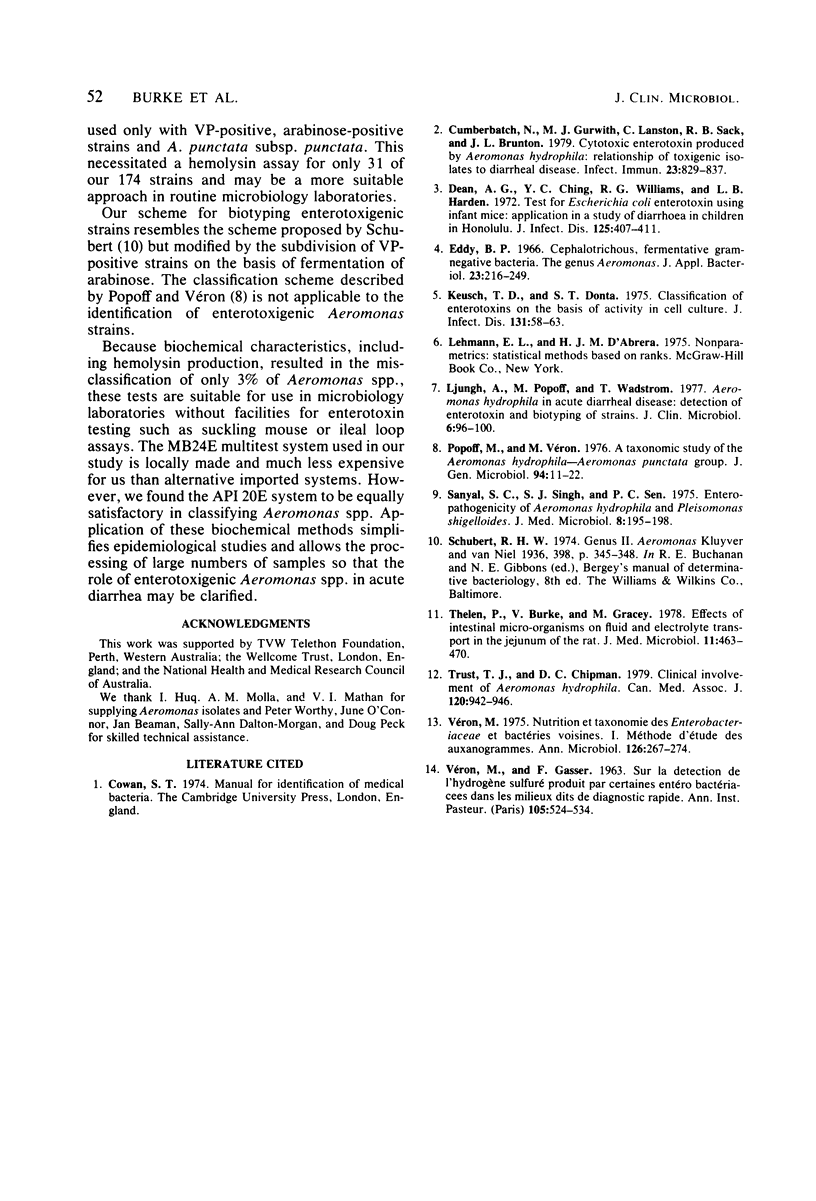Abstract
Biotypes of Aeromonas spp. correlated well with enterotoxin production in a study of 174 strains. Using biochemical characteristics determined by conventional methods and multitest systems, we correctly classified 93% of the strains with regard to enterotoxin production. Most of the enterotoxigenic strains were Voges-Proskauer (VP) positive and did not hydrolyze arabinose, but VP-positive strains which hydrolyzed arabinose were mainly non-enterotoxigenic. Aeromonas punctata subsp. caviae, which is VP negative and does not oxidize gluconate or produce gas from glucose, was non-enterotoxigenic. Although the number of other VP-negative strains was small, most were enterotoxigenic. Discrimination was improved so that 97% of the strains were correctly classified if the hemolysin assay was used either for all strains or for only the VP-positive, arabinose-positive and VP-negative, non-A. punctata subsp. caviae strains. Because the proposed classification system does not require facilities for carrying out in vivo assays such as suckling mouse or ileal loop methods, the identification of enterotoxigenic Aeromonas strains should be possible in diagnostic laboratories and will facilitate epidemiological studies of the role of these organisms in acute diarrhea.
Full text
PDF




Selected References
These references are in PubMed. This may not be the complete list of references from this article.
- Cumberbatch N., Gurwith M. J., Langston C., Sack R. B., Brunton J. L. Cytotoxic enterotoxin produced by Aeromonas hydrophila: relationship of toxigenic isolates to diarrheal disease. Infect Immun. 1979 Mar;23(3):829–837. doi: 10.1128/iai.23.3.829-837.1979. [DOI] [PMC free article] [PubMed] [Google Scholar]
- Dean A. G., Ching Y. C., Williams R. G., Harden L. B. Test for Escherichia coli enterotoxin using infant mice: application in a study of diarrhea in children in Honolulu. J Infect Dis. 1972 Apr;125(4):407–411. doi: 10.1093/infdis/125.4.407. [DOI] [PubMed] [Google Scholar]
- Keusch G. T., Donta S. T. Classification of enterotoxins on the basis of activity in cell culture. J Infect Dis. 1975 Jan;131(1):58–63. doi: 10.1093/infdis/131.1.58. [DOI] [PubMed] [Google Scholar]
- Ljungh A., Popoff M., Wadstrom T. Aeromonas hydrophila in acute diarrheal disease: detection of enterotoxin and biotyping of strains. J Clin Microbiol. 1977 Aug;6(2):96–100. doi: 10.1128/jcm.6.2.96-100.1977. [DOI] [PMC free article] [PubMed] [Google Scholar]
- Popoff M., Véron M. A taxonomic study of the Aeromonas hydrophila-Aeromonas punctata group. J Gen Microbiol. 1976 May;94(1):11–22. doi: 10.1099/00221287-94-1-11. [DOI] [PubMed] [Google Scholar]
- Sanyal S. C., Singh S. J., Sen P. C. Enteropathogenicity of Aeromonas hydrophila and Plesiomonas shigelloides. J Med Microbiol. 1975 Feb;8(1):195–198. doi: 10.1099/00222615-8-1-195. [DOI] [PubMed] [Google Scholar]
- Thelen P., Burke V., Gracey M. Effects of intestinal micro-organisms on fluid and electrolyte transport in the jejunum of the rat. J Med Microbiol. 1978 Nov;11(4):463–470. doi: 10.1099/00222615-11-4-463. [DOI] [PubMed] [Google Scholar]
- Trust T. J., Chipman D. C. Clinical involvement of Aeromonas hydrophila. Can Med Assoc J. 1979 Apr 21;120(8):942–946. [PMC free article] [PubMed] [Google Scholar]
- VERON M., GASSER F. SUR LA D'ETECTION DE L'HYDROG'ENE SULFUR'E PRODUIT PAR CERTAINES ENT'EROBACT'ERIAC'EES DANS LES MILIEUX DITS DE DIAGNOSTIC RAPIDE. Ann Inst Pasteur (Paris) 1963 Sep;105:524–534. [PubMed] [Google Scholar]


